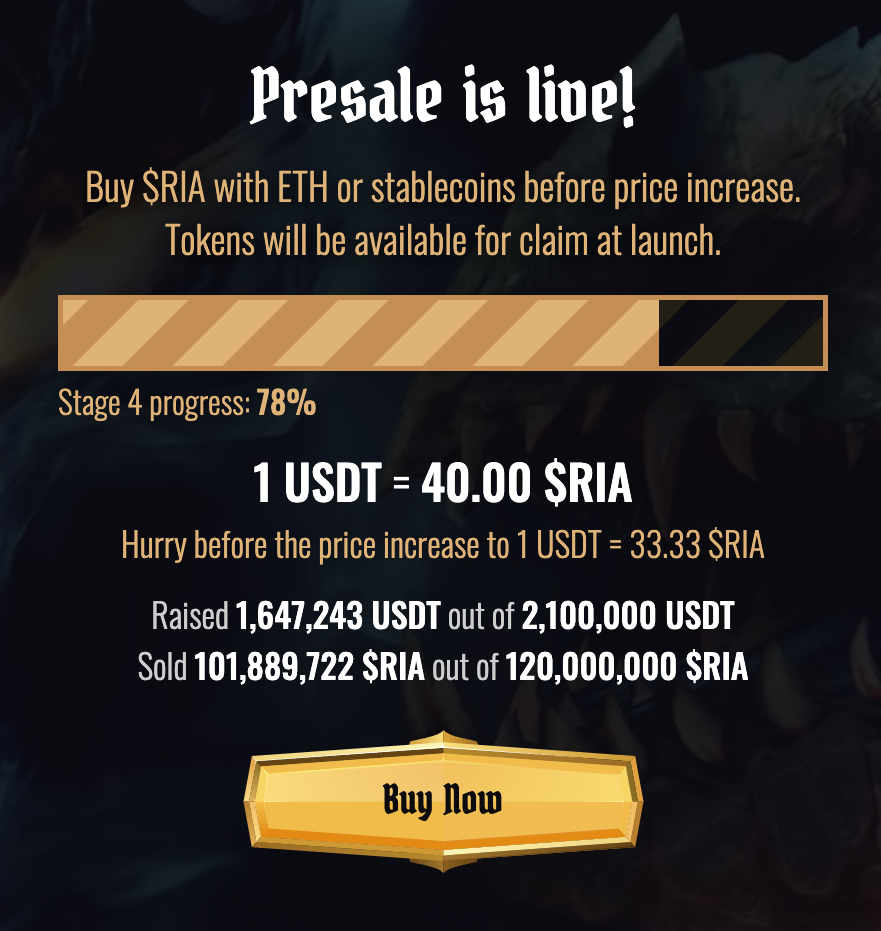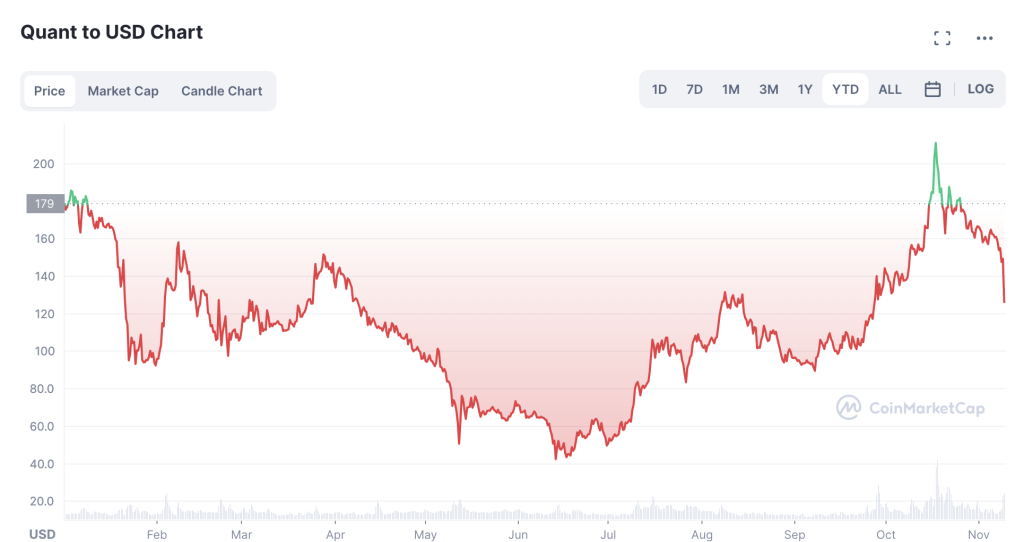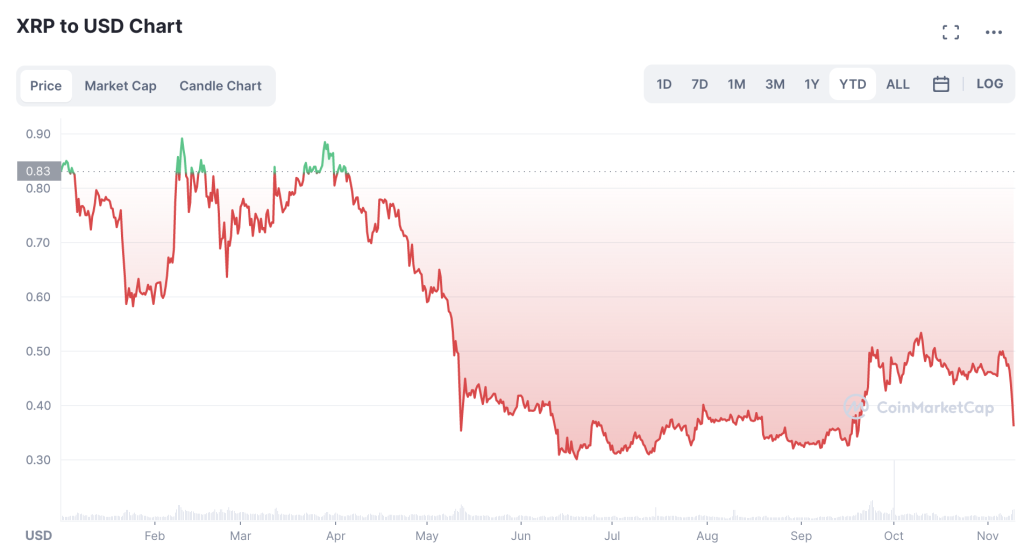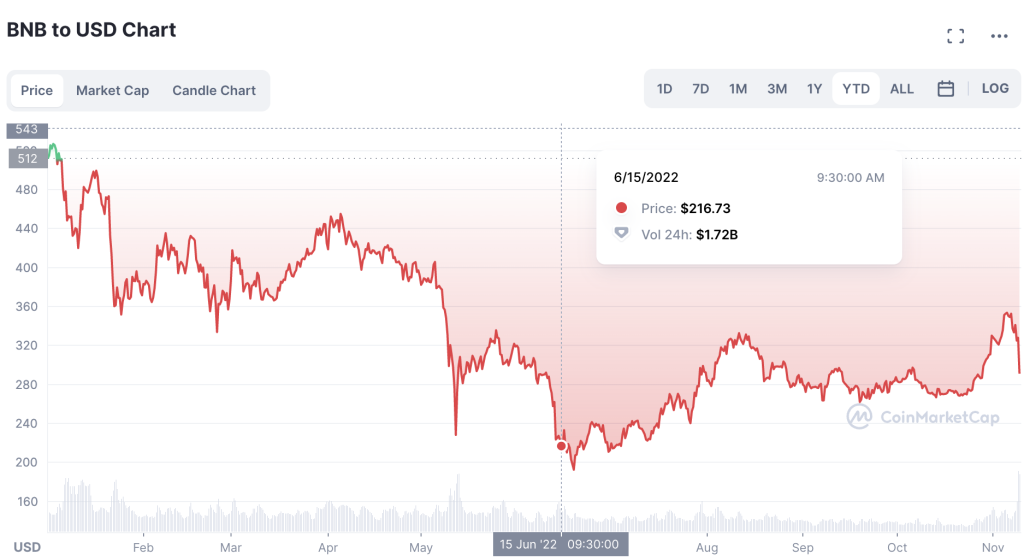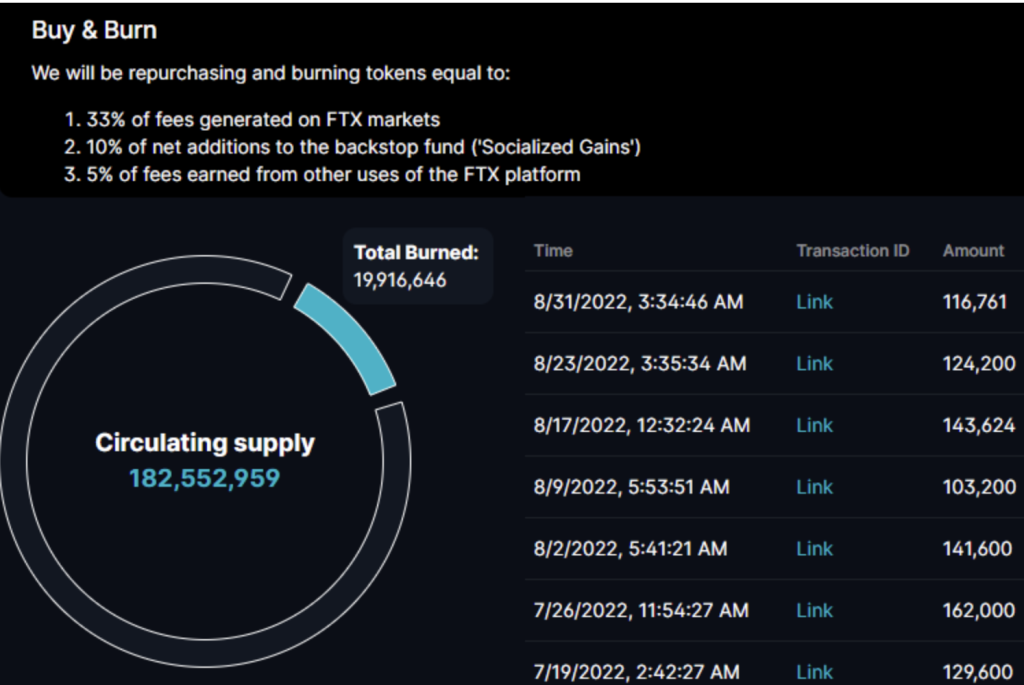Cryptocurrencies with an in-built burn mechanism limit their supply over time, increasing their value. The latest among them are Tamadoge and Terra Classic.
This guide gives you a list of the best deflationary cryptocurrencies that present major upsides due to their deflationary nature. Even Terra Classic, which was once brushed off as a vain attempt to revitalize the Terra blockchain, broke through market fundamentals as bulls took control to pump its price and peaked by 550% after the introduction of the 1.2% burn mechanism.
Best Deflationary Cryptocurrencies – Top List
- Fight Out: Deflationary Cryptocurrency on Presale Now
- Calvaria: Will Burn 20% off Presale Tokens
- Tamadoge: Memecoin with a 5% Burn rate
- Quant: A utility-based crypto with over 66% of supply Burnt
- XRP: Burns the Transaction Fee on The Ripple Network
- Terra Classic: LUNA-formed Token to Introduce 1.25 Burn
- Binance Coin: Crypto with an auto-burn mechanism
- FTX Token: Implemented an anti-inflation buy/burn schedule
- Polygon: One of the Best Deflationary Altcoins
What is a Deflationary Cryptocurrency?
- Cryptocurrencies that limit their supply over a period of time are deflationary cryptocurrencies.
- Limiting the supply is done by burning the crypto assets by sending them to the burn address.
- Burning cryptocurrencies increases their intrinsic value by following the law of supply and demand.
- Cryptocurrencies such as Dogecoin find it hard to be seen as a long-term investment before their value expands over time.
- Bitcoin is also an inflationary asset to a point. However, it has a deflationary protocol built in known as halving.
- Many cryptocurrency projects have implemented an automatic or manual burn mechanism to limit their supply and increase their value over time. Terra Classic, the community-driven crypto of the original Terra blockchain, reached its all-time high levels after the introduction of the 1.2% LUNA burn campaign.
Best Deflationary Cryptocurrencies – Complete Review
Here will take a closer look at the best deflationary cryptocurrencies with major upsides for both long and short-term investors.
Fight Out: Deflationary Crypto on Presale Now
As a platform that explores a highly unique and innovative category, Fight Out is anticipated to be one of the best cryptocurrency projects in the space from the day of its inception. The project is based on creating a space which can be utilized by users to potentially earn massive profits while also earning income on the side. As an initiative that was announced just recently, it has been gaining massive traction, thanks to its highly innovative concept and use case.
It is set in the M2E or Move 2 Earn genre, but easily breaks the limitations that many counterparts like STEPN featured, making it a better pick. Essentially, Fight Out lets users make working out a much easier, and more exciting thing, by adding incentives, rewards, and highly engaging instructions. With the goal of using crypto and NFTs as rewards, Fight Out aims to create a community that is mindful of fitness.
It features a metaverse avatar, that develops within the platform depending on the workout done by the user in real life. As one of the top Web3 initiatives currently, Fight Out features a deflationary token called FGHT. It is currently in its presale phase and has been amassing a massive community. Infact, the project managed to raise more than $2 million, merely days after the presale process started. There is little doubt that FGHT may be looking for some exceptional gains, mainly due to its deflationary nature and high utility.
Calvaria: Will Burn 20% of the Presale Tokens
Calvaria is one of the more interesting P2E cryptocurrencies to arrive this year. Sporting deflationary attributes, like the other two on the list, Calvaria is also undergoing the presale. Investing in it right now will allow you to claim your RIA tokens during the token refrigeration event.
Because of this cryptocurrency’s unique approach towards blockchain gaming – which we will discuss in the next paragraph – the presale tokens are going out fast. So, in order to counteract the selling pressure that will likely develop at the token generation event when the token lands on cryptocurrency exchanges, Calvaria has delegated 20% of the presale funds to the liquidity and buy bach. Under the buyback program, devs are going to buy and burn the token immediately – limiting its supply and making it a deflationary asset.
In hindsight, Calvaria is a card game similar to Gods Unchained, Spellfire, and Splinterlands. However, unlike the latter three, Calvaria takes a story-focused and inclusive approach to gaming. In addition to the standard PvE and PVP modes, Calvaria also features the P2E (Play-to-Earn) and F2P (Free-to-Play) mods.
The F2P mode is created keeping non-crypto gamers in mind. These gamers would not need to download a crypto wallet to access the game and won’t need to buy any card NFTs. They will also have access to in-game store commissions, card upgrades, and everything, the same as the blockchain gamers.
The P2E mode will focus on crypto gamers, who would have real ownership of their NFT cards on the platform. They will also be able to interact with Calvaria’s underlying DeFi mechanics, including prize pools and a gamified staking pool.
At the time of writing, Calvaria is closer to finishing the 4th phase of the presale and has raised upwards of 1.6 million USDT. To know about the expert’s forecast for Calvaria, check out our Calvaria price prediction.
Tamadoge: Memecoin with a 5% Burn rate
Tamadoge is a memecoin powering a virtual pet game of the same name. At the center of this game lie doge pets, known as Tamadoge pets. Each with a different look, strengths, weaknesses, and attributes, these Tamadoge pets can be owned by you and then customized and raised before being put into battle in a PvE ecosystem.
This Tamagotchi-like approach to gameplay, coupled with the doge aesthetics, allowed Tamadoge to become one of the biggest presale success stories of this year as it raised $19 million in record time and surpassed Ethereum’s ICO.
Tamadoge’s deflationary aspects come from transactions. According to the official whitepaper, each time a transaction is done using TAMA, 5% of the tokens spent will be burned completely to reduce its total supply, which is 2 billion coins.
After the conclusion of the presale, Tamadoge was listed on OKX, the world’s seventh-biggest cryptocurrency exchange by market capitalization. Devs soon dropped ultra-rare, rare, and standard Tamadoge NFTs that pumped the TAMA price by manifolds. Tamadoge was later listed on LBank and Uniswap.
While the token’s value has corrected to its later presale levels after reaching an all-time high, Tamadoge is still profitable to the project’s early movers. However, multiple games are on the way, and the roadmap of the project looks solid, making it possible for Tamadoge to experience a resurgence once again next year.
Quant: A utility-based crypto with over 66% of supply Burnt
Quant is another deflationary cryptocurrency that is making rounds as one of the best crypto assets this year. QNT is the native crypto of the Quant Network, a blockchain network built for enterprises to connect blockchains at a global scale. The network works towards reducing cost and accessing a wider crypto market by deploying decentralized applications on any blockchain using its multi-chain API called the Overledger.
Overledger allows developers to create and deploy apps without having deep knowledge of blockchain technology. All these factors combine to give Quant the ability to increase the blockchain adoption rate, which is why Quant was able to bounce back from its bearish low of $45 to nearly 50% of its all-time high of $220 in October. At the time of writing, Quant is trading at $135.
The developers of the Quant project burned 66% of the total supply in 2018 to limit its supply and turn it into a deflationary crypto. Investors looking for a well-established crypto asset that can increase the blockchain adoption rate and grow alongside major cryptocurrencies should invest in Quant.
XRP: Burns the Transaction Fee on The Ripple Network
Another deflationary currency in our list is XRP. This crypto asset is burned every time it is used as a transaction fee on the Ripple network. Doing so permanently removes XRP tokens from the circulating supply, limiting them and leaving them open for growth.
Starting with a 100 billion total supply when first introduced in 2013, XRP’s deflationary has reduced its total supply to only 99.98 billion.
Even with a lower-than-usual deflation rate, XRP’s unique use case and its importance to the crypto space, in general, allowed it to go on a bull run back in 2017 when it reached its all-time high of $3. While a massive retrace happened, XRP went on its second bull run in 2021 before retracing due to the 2022 crypto winter. At the time of writing, XRP has rebounded to $0.37, which is more than 20% from its June low.
Terra Classic: LUNA-formed Token to Introduce 1.2% Burn
Terra Classic is the native token of the forked Terra blockchain. Originally known as LUNA, Terra Classic came into existence after the death spiral of the Terra blockchain pushed LUNA into a hyperinflationary cycle, turning its 350 million supply to 6.5 trillion.
Coming fresh out of the crash and hyperinflationary, the LUNA community went on a LUNA burn campaign in an attempt to reduce its 6.5 trillion circulating supply.
Although initially proved unsuccessful, Terra Classic started making headlines once again after the community in control of the Terra chain introduced a 1.2% token burn. That news, coupled with the newly introduced staking pool, increased the community’s interest in Terra Classic, and the bulls took control, making Terra Classic surpass one milestone after the next. As a result, the token reached its all-time high of $0.00056.
While the value later retraced to $0.00018, an accumulation range formed within that range, and at the time of writing, Terra Classic is trading at $0.0001762.
Even though this crypto asset has no use case other than being tradeable and stackable, its rise attests to the fact that being a deflationary crypto is seen as a positive in the crypto space, and people are always ready to support such asset.
Binance Coin: Crypto with an auto-burn mechanism
Those interested in CEX cryptos with readily available utility will find Binance Coin to be a suitable investment. Binance Coin is the native token of Binance, the world’s leading cryptocurrency exchange that supports over 600 crypto assets and has a 24-hour trading volume that exceeds 76 billion.
Binance Coin is the world’s fourth biggest cryptocurrency by market capitalization, with a total supply of 159 billion out of its max supply of 200 billion.
Binance launches a buyback and burn program every quarter to decrease the supply of BNB tokens and thereby increase their value. The latest supply of 159 billion tokens is the result of the 20th quarterly burn.
At the time of writing, Binance is trading at $304.
FTX Token: Implemented an anti-inflation buy/burn schedule
Another cryptocurrency exchange token to make it to our list is FTT. Like Binance coin, FTX too is used to reduce the trading fees on the cryptocurrency exchange.
Headed by Sam Bankman-Fried, once seen as the “good guy of crypto”, FTT became one of the best deflationary cryptocurrencies after FTX introduced a Buy and Burn program – FTX would buy back the FTT token and burns it according to a weekly schedule.
As of 2024, the insolvency of FTX has led to FTT’s value dropping drastically from $22 to under a dollar before bouncing. Some are still buying FTT however expecting the bankrupt exchange to be relaunched.
Polygon: One of the Best Deflationary Altcoins
Polygon introduced a token burn mechanism back in January 2022 known as Ethereum EIP -1559. According to the official blog by POlygon, this mechanism aims to “burn the native MATIC token” and provide “better fee visibility” to the users.
The official website states that over 4.15 million tokens have been burned, with over 2.96 million tokens currently waiting to be burned. Burning is a three-step process that initiates on Polygon and finishes on the Ethereum blockchain.
At the time of writing, Polygon is trading sideways in the $1.16-$0.90 range.
Conclusion
Being a deflationary crypto is a major asset for every cryptocurrency. The limited supply brings the supply-demand law into play, giving the token the potential to experience a massive increase in price. Even tokens like Terra Classic with no discernible use case have rallied to all-time highs due to the burn mechanisms alone.
And when that burn mechanism is coupled with a great use case, you get a crypto asset with a definite upside for all investors. Fight Out is among those cryptocurrencies. Offering highly advanced and innovative tools for fitness, Fight Out has the makings of what could become the world’s best crypto-fitness platform. Currently, the ecosystem’s FGHT token is on presale, and has been surging in demand rapidly.
Related Articles
Most Searched Crypto Launch - Pepe Unchained
- Layer 2 Meme Coin Ecosystem
- Featured in Cointelegraph
- SolidProof & Coinsult Audited
- Staking Rewards - pepeunchained.com
- $10+ Million Raised at ICO - Ends Soon
FAQs on Deflationary Tokens
What is a deflationary cryptocurrency?
A deflationary cryptocurrency is one whose total token supply decreases over time. It is done by implementing an automatic burning mechanism or scheduled burns organized by the crypto developers. In the case of auto-burning, token burns are tied to the transaction process. For instance, Tamadoge burns 5% of the tokens spent on transactions.
Is there a full list of deflationary cryptocurrencies?
For those interested in a full list of deflationary cryptocurrencies, CryptoSlate provides a list of the top 21 cryptocurrencies of that day. However, for those looking for the best deflationary cryptocurrencies with major upsides, the list we have reviewed will suffice.
What are the best deflationary cryptocurrencies to invest in right now?
The best deflationary cryptocurrencies to invest in this year are Fight Out and Calvaria. Along with being deflationary assets, these cryptocurrencies are also undergoing their presale. Thus, this presents a great opportunity to earn multi-fold gains for the early movers as the price of these crypto assets grows with each stage.
What's an example of hyper-deflationary cryptocurrency?
Hyper deflationary cryptocurrencies are those that claim to limit the token supply rapidly. These claims are nothing more than marketing gimmicks meant to draw in investors and then perform. These tokens hardly show any market action, and even when listed on major cryptocurrency exchanges, such tokens often experience a downtrend. Therefore, it is recommended that investors see beyond the deflationary traits of crypto assets before investing in them. Consequently, we have paid attention to the special feature of the tokens in our guide.

